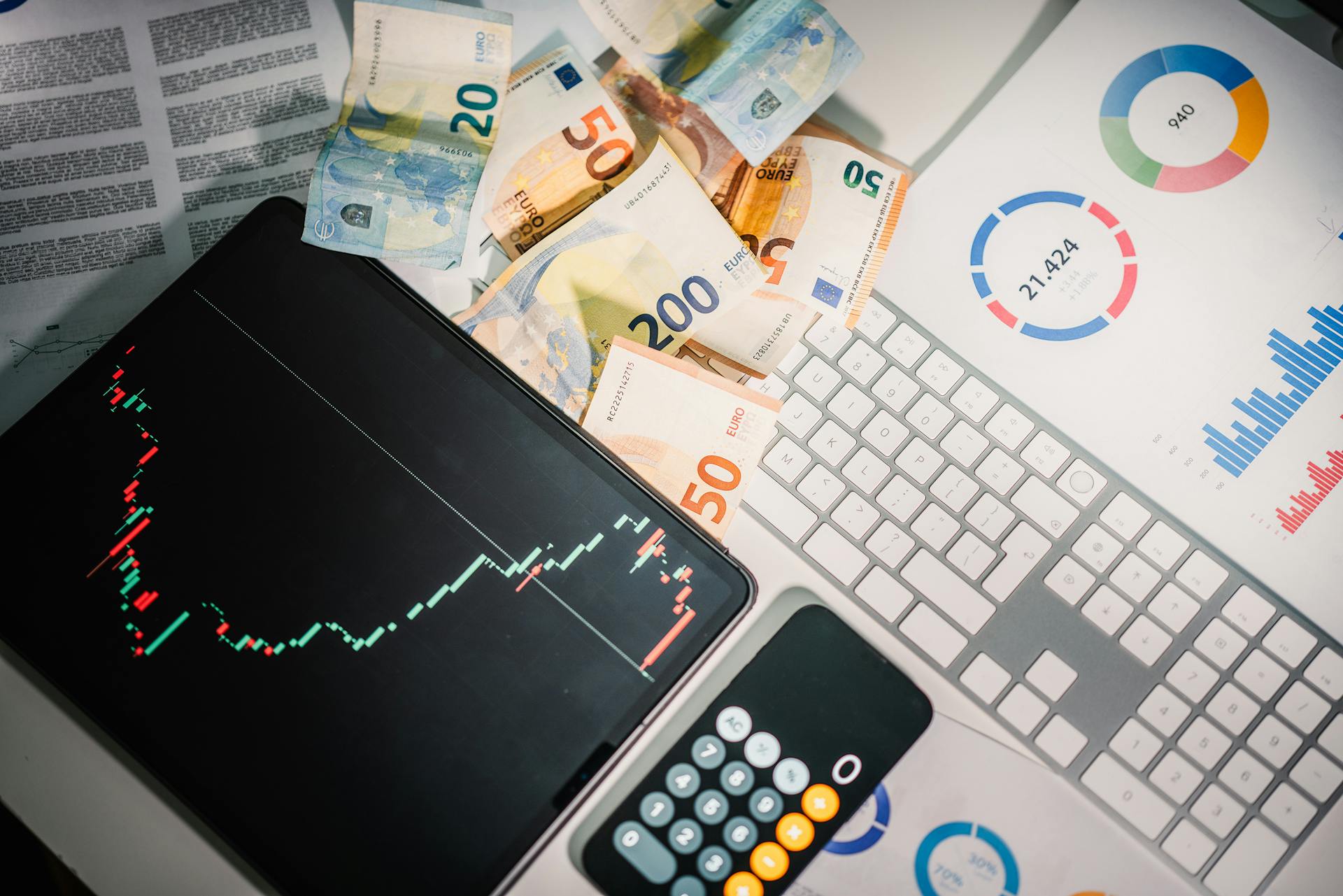
Trading XAUUSD can be a bit overwhelming, especially for beginners.
The XAUUSD is a currency pair that represents the value of one ounce of gold in relation to the US dollar.
To start trading XAUUSD, you'll need to open a trading account with a reputable online broker.
Choose a broker that offers competitive spreads, reliable customer support, and a user-friendly trading platform.
As a beginner, it's essential to start with a demo account to practice trading with virtual money before risking real capital.
Expand your knowledge: Demat and Trading Account
Getting Started
First, you need to find a reputable trading platform that meets your needs. Consider the key features that will help you succeed in the gold market.
Real-time charts and analysis tools are essential for spotting opportunities. You want to see live prices and trends happening now, and tools like moving averages can help you do just that.
A user-friendly interface is also crucial. You don't want to spend time navigating menus when you could be focusing on understanding the markets.
Fast order execution is vital for getting the best prices. Slow platforms can miss chances, so choose one that executes trades quickly.
To ensure you have access to the data you need, look for a platform that provides current pricing data and news. Historical charts can also help you analyze how markets moved before.
Two-factor authentication adds an extra layer of security to your account. This is especially important when you're dealing with sensitive financial information.
Here are some key features to look for in a trading platform:
- Real-time charts and analysis tools
- Easy-to-use interface
- Fast order execution
- Access to data
- Two-factor authentication
- Strong encryption
- Regular security checks
- Clear privacy policy
By considering these features, you can set yourself up for success in the XAUUSD market.
Understanding XAU/USD
The XAU/USD trading pair represents the exchange rate between gold and the US dollar, with one ounce of gold costing as many USD as the exchange rate indicates.
The price of gold is influenced by various factors, including demand from sectors such as jewellery, investors, and industrial applications.
A basic understanding of the XAU/USD chart is crucial to successful trading, with the vertical 'Y' axis representing the Gold price in USD and the horizontal 'X' axis representing time.
Here are the common chart types used to showcase Gold price movement over time:
- Line charts
- Bar charts
- Candlestick charts
A candlestick chart is the most commonly used type, with each candle representing a specific time period, such as 1 minute, 5 minutes, 15 minutes, 30 minutes, 1 hour, 4 hours, one day, one week, or one month.
Understanding the Basics
The XAU/USD trading pair is a unique combination of gold, represented by the ticker XAU, and the United States dollar (USD). It's essentially the exchange rate between the two, showing how many USD it takes to buy one ounce of gold.
The "X" in XAU stands for "Index", while "AU" stands for "Aurum", the Latin word for gold. This pair is also traded against other popular currencies, such as the Australian dollar, Swiss franc, euro, and British pound.
On a similar theme: Dollar Currency Trading
Gold has been used historically as currency and was used to establish the gold standard, where paper money was redeemable for gold. This practice is no longer in use, but gold remains a liquid reserve for central banks.
Gold is a vital element of finance and investing, often seen as a safety net against economic uncertainties. It's a source of returns for investors and a reliable means of storing value.
The XAU/USD pair is considered a safe-haven asset, making it an appealing addition to a portfolio. When traditional markets are under duress, gold tends to maintain or even increase in value, allowing traders to profit from price fluctuations.
Xau/Usd Historical Performance
The XAU/USD historical performance is a story of resilience and adaptability. The history of gold dates back to ancient civilizations, but its value on the market has fluctuated significantly over the years.
During times of economic uncertainty, like the Great Depression and World War II, the price of gold has spiked substantially. After World War II ended, the Bretton Woods Agreement was established, fixing the US dollar to gold at a rate of $35 per ounce.
The agreement collapsed in 1971, allowing gold to float freely on the market, leading to a surge in prices during the 1970s. Prices rose due to inflation and political uncertainty.
Gold prices stagnated for a while, but then began to rise rapidly during the 2000s. Geopolitical uncertainties, financial crises, and rising inflation all contributed to this uptrend.
After a mixed performance in the first half of the 2010s, gold eventually resumed its uptrend, this time amid rock-bottom interest rates.
Related Instruments
When trading XAU/USD, it's essential to consider related instruments that can impact the price of gold.
Silver, often seen as a substitute for gold, can have a significant impact on the XAG/USD price, which can in turn affect the XAU/USD price.
The Australian Dollar (AUD) is a significant currency in global trade, and its fluctuations can influence the price of gold, as seen in the XAU/AUD exchange rate.
The Swiss Franc (CHF) is known for its stability, and its value can affect the price of gold, making it a related instrument to consider when trading XAU/USD.
The Euro (EUR) is a widely traded currency, and its fluctuations can have a ripple effect on the price of gold, making it a related instrument to keep an eye on when trading XAU/USD.
US Dollar Value
The value of the US dollar plays a significant role in trading gold, as the two assets are inversely related. This means that when the US dollar appreciates, gold prices tend to decline in terms of the US dollar.
The reason for this inverse relationship is that gold's value increases in relation to other global currencies when the US dollar appreciates. This is because gold is a safe-haven asset that investors turn to during times of economic uncertainty, and a strong US dollar makes it more expensive to buy gold.
The value of the US dollar is influenced by interest rates, but these have no bearing on the price of gold in the long run. Instead, supply and demand determine the price of gold, just like they do for most basic commodities.
Here are some key factors that affect the value of the US dollar:
- Interest rates: Rising interest rates are usually negative for stocks, but bullish for gold prices.
- Economic growth: Fluctuations in economic growth or crises, such as in the economy of China, can affect the value of the US dollar.
- Global currency movements: The US dollar's value can be influenced by its relationship with other global currencies.
The US dollar's value is also closely tied to the price of gold, as the two assets are often seen as inversely related. This means that traders need to be aware of the US dollar's value when trading gold, as it can have a significant impact on the price of gold.
Recommended read: Can You Trade Xauusd in the Us
Technical Analysis
Technical analysis is a crucial aspect of trading XAUUSD, and it's based on examining historical price data to predict future price movements. This approach is built on the principle that price patterns tend to repeat over time and that past market behavior can provide clues about future movements.
To identify potential trade opportunities, traders can use technical indicators like Moving Averages, Relative Strength Index (RSI), Moving Average Convergence Divergence (MACD), or Bollinger Bands. These tools can help identify trends, measure market momentum, and signal potential reversals.
Support and resistance levels are also essential in technical analysis, representing prices where buyers have previously entered the market to halt a downward trend or where sellers have overwhelmed buyers to stop an upward trend. Identifying these levels can help traders determine entry and exit points for their trades.
Discover more: Xauusd Analysis
MT4 & MT5 Guide
To start trading the Gold symbol (XAUUSD) on Metatrader 4/5, you need to first locate this symbol in the 'Market Watch' window.
The 'Market Watch' window is a comprehensive list of all the available instruments you can trade with your broker. To refresh the list and include all available currency pairs, commodities, indices, and stocks, right-click anywhere in the 'Market Watch' window and select 'Show All'.
This will display the XAUUSD symbol in the list. If it's not immediately visible, don't worry, it's just a matter of refreshing the list.
To open a chart for XAUUSD, you can drag and drop the symbol onto the main workspace or right-click it and select 'Chart Window'. A new chart detailing the live Gold price action against the US dollar will be displayed on your screen.
Understanding Chart
The vertical 'Y' axis on a XAUUSD chart represents the Gold price in USD, while the horizontal 'X' axis represents time.
Each point on the chart indicates the Gold price at a specific time, often linked as line, bar, or candlestick charts to showcase Gold price movement over time.
The most commonly used chart type is the candlestick chart, with each candle representing a specific time period, such as 1 minute, 5 minutes, 15 minutes, 30 minutes, 1 hour, 4 hours, one day, one week, or one month.
The candlestick's body shows the opening and closing prices for the period, and the wicks (or shadows) indicate the highest and lowest prices.
A Green candlestick denotes a bullish (upward) movement, where the closing price was higher than the opening price.
Conversely, a Red candlestick signifies bearish (downward) movement, where the closing price was lower than the opening price.
One standard lot in gold trading is equivalent to 100 ounces.
Understanding the basics of a XAUUSD chart is crucial to successful trading, as it provides valuable insights into market behavior and potential future price movements.
Risk Management
Risk management is the cornerstone of successful trading, particularly in the volatile world of currency trading. Effective risk management allows you to cap potential losses, protect your trading capital, and navigate market volatility more confidently.
To manage your risks, set a "stop-loss" price to cut losses if prices turn against you, and a "take-profit" price to sell if prices look good. A commonly used risk-reward ratio is 1:2, meaning the potential profit should be at least twice the possible loss.
Adjusting your position size is another important risk management tool. The amount of capital risked on each trade should align with your risk tolerance. A common rule of thumb is to risk no more than 1-2% of your trading account on a single trade.
Here are some key risk management strategies to keep in mind:
- Set a stop-loss price to cut losses if prices turn against you.
- Set a take-profit price to sell if prices look good.
- Risk no more than 1-2% of your trading account on a single trade.
Risk Management
Risk management is the backbone of successful trading, particularly in the volatile world of currency trading. Effective risk management is indispensable for preserving your trading capital and ensuring longevity in the market.
Risk management in forex trading involves setting predefined risk parameters to protect your trading capital and navigate market volatility more confidently. By capping potential losses, you can maintain trading discipline and control emotions.
To manage your risks, decide on the most you could afford to lose and set a "stop-loss" price to cut losses if prices turn against you. Always consider the risk-reward ratio before entering a trade, aiming for a potential profit at least twice the possible loss.
Adjusting your position size is another important risk management tool. Risk no more than 1-2% of your trading account on a single trade, as a common rule of thumb. This means if your account has $10,000, you should not risk more than $100-$200 on any trade.
Some common mistakes to avoid in XAUUSD trading include neglecting risk management, trading without a stop loss, and trading with excessive leverage. Always set a stop loss for each trade and ensure that your trade size aligns with your risk tolerance and account size.
Here are some key data releases and statements to watch out for when trading XAU/USD:
- Major central banks worldwide, including the United States (Federal Reserve), the eurozone (ECB), Japan (BOJ), China (PBoC), and Australia (RBA), for monetary policy decisions and statements.
- US Treasury Department statements related to US fiscal policy and debt.
- Gold mining companies for data on production volumes, exploration updates, and financial performance.
- Commodity exchanges like the COMEX (Chicago Mercantile Exchange) for determining gold futures prices.
- Retail and wholesale associations related to jewellery, bullion, and precious metals for insights into physical demand for gold.
- Organization of the Petroleum Exporting Countries (OPEC) for oil prices and geopolitical developments related to oil production.
Pros and Cons
Risk management is crucial in trading, and understanding the pros and cons of a particular strategy can help you make informed decisions. Gold trading, in particular, has its own set of advantages and disadvantages.
Gold has historically been a secure place for investors during periods of economic and geopolitical uncertainty. It's a buffer against inflation and market downturns, and its value usually increases when other assets are struggling.
One of the key benefits of gold trading is its low correlation with other assets. This makes it an excellent diversification strategy, which can lower overall risk and increase long-term profits. By diversifying your portfolio, you can offset losses from underperforming assets.
However, gold trading also has its downsides. Its price can be volatile, making it challenging for short-term traders to navigate abrupt price swings. Unlike stocks or bonds, gold doesn't generate revenue, which means you won't earn interest or dividends.
Here are some key pros and cons of gold trading to consider:
Understanding these pros and cons can help you make informed decisions about your trading strategy and risk management approach.
Frequently Asked Questions
Is XAUUSD easy to trade?
XAUUSD can be a challenging currency pair to trade due to its high volatility and large price movements. If you're new to Forex trading, it's essential to understand the unique factors that influence gold prices before getting started.
How to trade XAUUSD as a US citizen?
As a US citizen, you can trade XAU/USD through CFTC-approved brokers, which offer a secure and regulated trading environment. Find a CFTC-approved broker to start trading gold with confidence.
Sources
- https://www.keenbase-trading.com/how-to-trade-xauusd-gold/
- https://www.axi.com/int/trade/cfds/commodities/precious-metals/xau-usd
- https://www.litefinance.org/trading/trading-instruments/commodities/xauusd/
- https://wmt.wecopytrade.com/what-is-xauusd/
- https://fx2funding.com/blog/how-to-trade-gold-xau-trading-strategies-indicators-and-tips/
Featured Images: pexels.com


